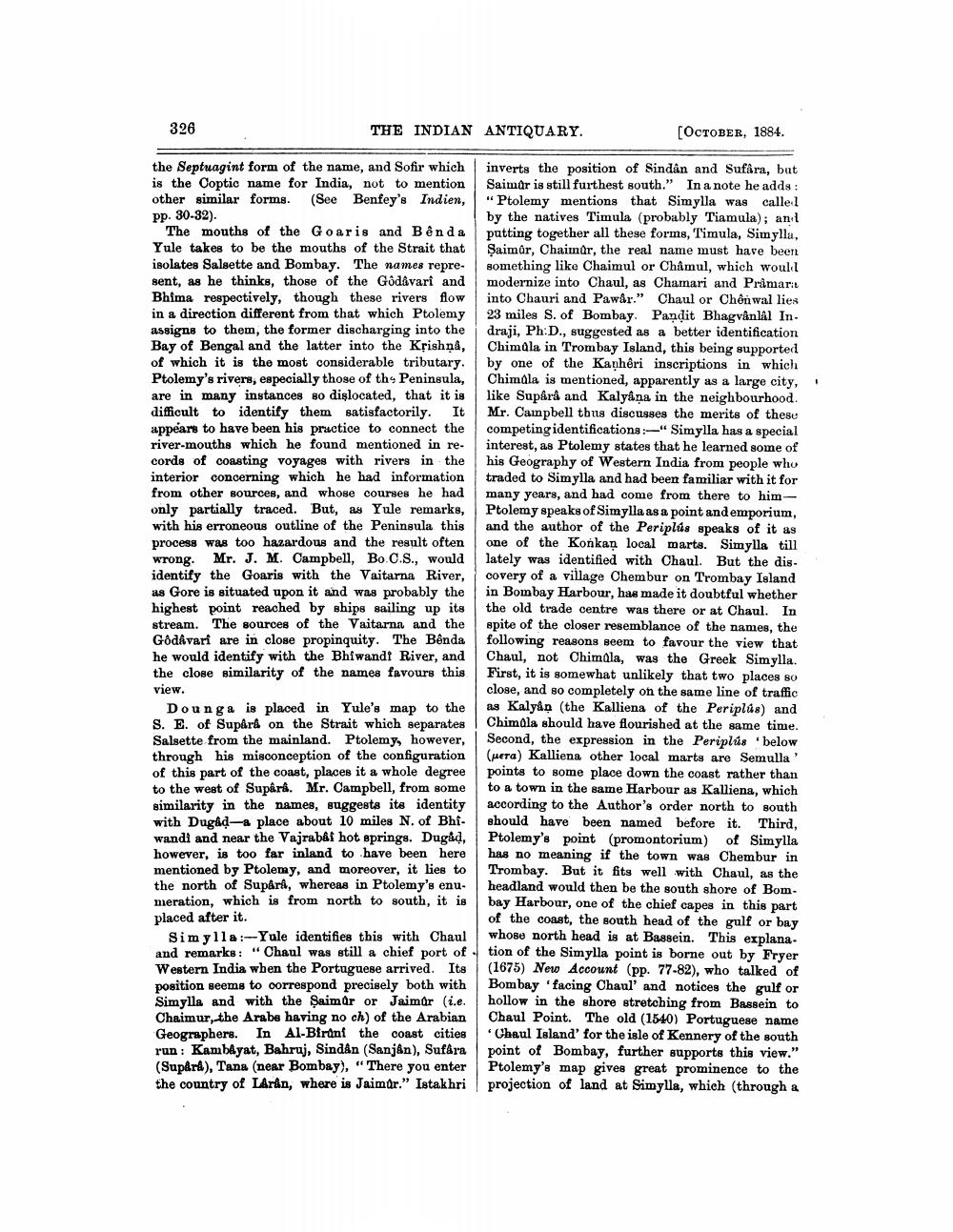________________
326
THE INDIAN ANTIQUARY.
[OCTOBER, 1884.
the Septuagint form of the name, and Sofir which is the Coptic name for India, not to mention other similar forms. (See Benfey's Indien, pp. 30-32).
The mouths of the Goaris and Benda Yule takes to be the mouths of the Strait that isolates Salsette and Bombay. The names represent, as he thinks, those of the Godavari and Bhima respectively, though these rivers flow in a direction different from that which Ptolemy assigns to them, the former discharging into the Bay of Bengal and the latter into the Krishna, of which it is the most considerable tributary. Ptolemy's rivers, especially those of thy Peninsula, are in many instances so dislocated, that it is difficult to identify them satisfactorily. It appears to have been his practice to connect the river-mouths which he found mentioned in records of coasting voyages with rivers in the interior concerning which he had information from other sources, and whose courses he had only partially traced. But, as Yule remarks, with his erroneous outline of the Peninsula this process was too hazardous and the result often wrong. Mr. J. M. Campbell, Bo C.S., would identify the Goaris with the Vaitarna River, as Gore is situated upon it and was probably the highest point reached by ships sailing up its stream. The sources of the Vaitarna and the Godavart are in close propinquity. The Bênda he would identify with the Bhiwandt River, and the close similarity of the names favours this view.
Dounga is placed in Yule's map to the S. E. of Supera on the Strait which separates Salsette from the mainland. Ptolemy, however, through his misconception of the configuration of this part of the coast, places it a whole degree to the west of Supära. Mr. Campbell, from some similarity in the names, suggests ita identity with Dugad-a place about 10 miles N. of Bhiwandi and near the Vajrab&f hot springs. Dugåd, however, is too far inland to have been here mentioned by Ptolemy, and moreover, it lies to the north of Supârâ, whereas in Ptolemy's enumeration, which is from north to south, it is placed after it.
Simylls --Yule identifies this with Chaul and remarks: "Chaul was still a chief port of Western India when the Portuguese arrived. Its position seems to correspond precisely both with Simylla and with the Saimûr or Jaimur (i.e. Chaimur, the Arabs having no ch) of the Arabian Geographers. In Al-Biront the coast cities run: Kambayat, Bahruj, Sindán (Sanjan), Sufara (Supara), Tana (near Bombay), "There you enter the country of Lørån, where is Jaimar." Istakhri
inverts the position of Sindân and Sufâra, but Saimar is still furthest south." In a note he adds: "Ptolemy mentions that Simylla was callel by the natives Timula (probably Tiamula); an! putting together all these forms, Timula, Simylla, Şaimôr, Chaimur, the real name must have been something like Chaimul or Chamul, which woull modernize into Chaul, as Chamari and Primarit into Chauri and Pawår." Chaul or Chônwal lies 23 miles S. of Bombay. Pandit Bhagvånlal Indraji, Ph:D., suggested as a better identification Chimala in Trombay Island, this being supported by one of the Kanhêri inscriptions in which Chimala is mentioned, apparently as a large city, like Supära and Kalyana in the neighbourhood. Mr. Campbell thus discusses the merits of these competing identifications :-" Simylla has a special interest, as Ptolemy states that he learned some of his Geography of Western India from people who traded to Simylla and had been familiar with it for many years, and had come from there to himPtolemy speaks of Simylla as a point and emporium, and the author of the Periplús speaks of it as one of the Konkan local marts. Simylla till lately was identified with Chaul. But the discovery of a village Chembur on Trombay Island in Bombay Harbour, has made it doubtful whether the old trade centre was there or at Chaul. In spite of the closer resemblance of the names, the following reasons seem to favour the view that Chaul, not Chimala, was the Greek Simylla. First, it is somewhat unlikely that two places 80 close, and so completely on the same line of traffic as Kalyan (the Kalliena of the Periplás) and Chimala should have flourished at the same time. Second, the expression in the Periplus below (uera) Kalliena other local marts are Semulla' points to some place down the coast rather than to a town in the same Harbour as Kalliena, which according to the Author's order north to south should have been named before it. Third, Ptolemy's point (promontorium) of Simylla has no meaning if the town was Chembur in Trombay. But it fits well with Chaul, as the headland would then be the south shore of Bom. bay Harbour, one of the chief capes in this part of the coast, the south head of the gulf or bay whose north head is at Bassein. This explana. tion of the Simylla point is borne out by Fryer (1675) New Account (pp. 77-82), who talked of Bombay 'facing Chaul and notices the gulf or hollow in the shore stretching from Bassein to Chaul Point. The old (1540) Portuguese name
Chaul Island' for the isle of Kennery of the south point of Bombay, further supports this view." Ptolemy's map gives great prominence to the projection of land at Simylla, which (through a




